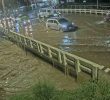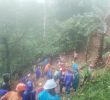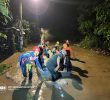“Maayo pa ang mga batan-on nakahuna-huna og repares aning bukid. Naghinaut ko nga daghan pang sama nila ang mohimo ani (I thank the youth for taking action to reforest our mountains. I hope more will do the same thing),” said Alice Lindasan, one of the residents, noting that nothing of this sort of help had been done to their community before.
By JOHN RIZLE L. SALIGUMBA
Davao Today
COMPOSTELA, Compostela Valley, Philippines — They gathered here for one common goal. That is to bring hope for the people and Mother Nature.
About 3,000 youth and students from all over Mindanao planted a total of 3,550 seedlings of both native timber and fruit-bearing trees — an appropriate activity to celebrate Earth Day last Monday in the farflung village of Ngan in this town.
Seeing for the first time the “strength” of typhoon Pablo with all its ruins and that, Paul Samson, a college student from Davao City, told davaotoday.com the help they extended in this remote place may be minute, but is very “basic” especially in areas hit by typhoons.
Ngan is one of the villages badly-damaged by Pablo (International name: Bopha) last December. And the entire province is still recovering from the damages it brought, according to Compotela’s Municipal Administrator Atilano Garcia.
The town used to have thick forest covers. But the large-scale logging company, the Valderrama Lumber Manufacturers Co., Incorporated, had denuded most of the mountains while large areas of land were converted into agri-business plantations.
Compostela’s livelihood largely depends on thousands of hectares of banana plantations owned by foreign-owned companies if not under the under the grower-ship deal with local suppliers. But when Pablo struck, practically no banana was left without damage.
The Ngan-Panansalan-Pagsabangan Forest Resource Management Cooperative, said Garcia, is still engaged in logging though “it’s not currently operating.”
“Rainforestation is an effective means to help the communities in the long-term,” said Joss De Leon, spokesperson of Tulong Kabataan in Zamboanga City.
He challenged the youth to take a proactive role against “those responsible for environmental destruction,” referring to foreign large-scale logging and mining companies, whom he said, “benefit from our rich natural resources.”
“We cannot bring back the lives lost. But the youth must unite with the people to protect life,” he said.
More than a thousand were killed and over 800 were missing when Pablo hit Mindanao more than four months ago.
Local residents expressed their gratefulness over the Mindanao-wide tree planning for rehabilitation and reforestation activity headed by Tulong Kabataan and Balsa Mindanao.
In Purok 28, Sitio Spur 2 of the same village, for example, residents said they would take care of the trees as they would benefit from it.
“If it’s a fruit tree, we can eat the fruit. If it’s timber we can use it,” said Ricardo Bandalan, the Purok Leader and one of the original inhabitants of the area.
He shared they are still on the stage of recovery but relief support have become irregular especially in their area which is actually a boundary of Compostela Valley and Cateel, Davao Oriental. There is no clear-cut geographic boundary, he said, but a “political boundary.”
“You can decide for yourself which village to reside,” Bandalan said adding there have been advantages to some who belong to Cateel especially on the help they received after Pablo.
“Those from Cateel received tin roofs, temporary shelter and utensils but we have not,” he said. He shared they have found ways to secure livelihood. But, the sunny weather only started this March and it would take three months to clean the fields.
Bandalan hopes that they would still be given materials for their homes as well as seeds, fertilizers, pesticides and farm tools so they could recover faster.
Residents here are mostly peasants who subsist on corn or vegetables.
“Maayo pa ang mga batan-on nakahuna-huna og repares aning bukid. Naghinaut ko nga daghan pang sama nila ang mohimo ani (I thank the youth for taking action to reforest our mountains. I hope more will do the same thing),” said Alice Lindasan, one of the residents, noting that nothing of this sort of help had been done to their community before.
“This will really help us. Who knows, after many years, the youth would return here and we would harvest the fruits of these trees together,” she said.
Lindasan has asked the government to intensify efforts for rehabilitation as they are more than willing to take part, only that, they don’t have resources.
“This is a big call for all of us. Many areas in Compostela Valley have been damaged by large-scale (legal and illegal) logging, mining, land conversion and other activities. Tropical rainforestation is critical,” said Lemuel Manalo of the Ecotenista movement, environmental arm of the Ateneo de Davao University’s student government.
Manalo said that their next move should be giving education to the youth, more community visits to discuss the state of the Philippine environment “and a whole year of rainforestation.” (John Rizle L. Saligumba/davaotoday.com)










